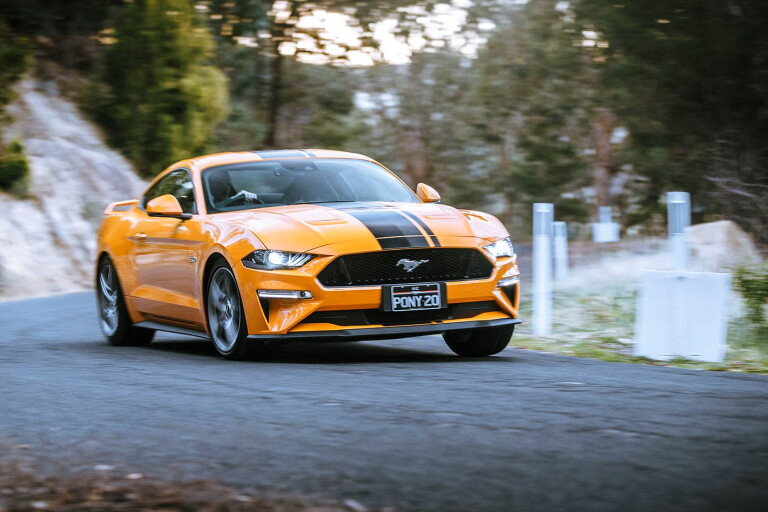
Score breakdown
Things we like
- A modern muscle car with great street cred, V8 soundtrack, manual and auto transmissions, auto braking
Not so much
- Thirsty V8, impractical rear-seats, sub-optimal crash-protection
What stands out?
The look. The Ford Mustang is a tough, muscular looking car as only the US of A can produce. But modern engineering has elevated the way it goes, stops and steers.
It is an every-day proposition, too – it even makes the most of your smartphone. The Mustang comes in coupe and convertible body styles and offers V8 and turbocharged four-cylinder engine options.

What might bug me?
Concern about what might happen if you were to crash in your Mustang. Safety authority ANCAP awarded it only three stars for safety, of a possible five mostly due to its poor rear occupant protection. (For more on Mustang safety, please open the Safety section below.)
You’ll love the sound the V8 Mustang makes, however you can't dial things down a little when you just feel like a relaxing ride.
On the other hand, if you have a four-cylinder Mustang High Performance 2.3L, it’s missing out on that V8 soundtrack altogether. The good news is the Mustang High Performance 2.3L has received a power and torque boost, steers better than the heavier V8, and is no longer known the not-so-sporty EcoBoost moniker.
In a Mustang High Performance 2.3L, driving at 80km/h on your space-saver spare wheel until you can fix your full-sized flat tyre.
In a Mustang V8, concern about leaving your muscle car by the roadside while you seek to get a flat tyre repaired. There is no spare at all – just pressure monitors that will warn you when trouble is coming. If it’s a slow leak, there's a tyre inflation kit that allows you to drive to a garage.
What body styles are there?
A two-door coupe, which Ford calls the Fastback, and a two-door convertible with a cloth roof, called the Convertible.
The Mustang drives its rear wheels, and is classed as a sports car, lower priced.
What features do all Mustangs have?
- Active safety including adaptive cruise control, autonomous emergency braking, lane-departure warning and lane keeping assist.
- Bluetooth connectivity and audio streaming via Ford’s excellent SYNC 3 suite.
- Satellite navigation, displayed on an 8.0-inch touchscreen.
- Reversing camera.
- Support for Apple Car Play and Android Auto, which allow you to display some apps from compatible smartphones on the car’s touchscreen and control them from there.
- 390-watt 12-speaker sound system with amplifier and subwoofer.
- Customisable 12-inch digital display cluster in place of analogue gauges.
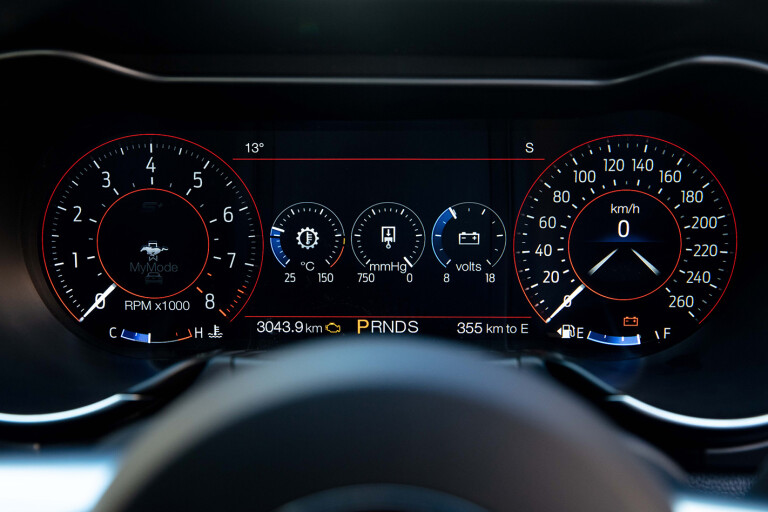
- Leather interior trim, and six-way power-adjusted, heated and ventilated front seats.
- Heated steering wheel.
- FordPass Connect embedded modem with remote vehicle functionality (including vehicle lock/unlock etc).
- Keyless entry and start, which allows you to lock, unlock and start the car without taking the electronic key from your pocket or bag.
- Dual-zone climate-control, which allows the driver and front passenger to set different temperatures for either side of the cabin.
- Rain-sensing windscreen wipers.
- Auto headlamps that sense the lighting conditions and turn themselves on and off.
- Auto-levelling LED headlights, LED fog-lamps and LED daytime running lights.
- Interior ambient lighting with colour adjustment.
- On manual-gearbox Mustangs, hill-start assist – which automatically prevents the car from rolling backwards when you need to start from rest on a slope.
- A tyre-monitoring system, which warns you if a tyre’s inflation pressure drops below a safe level. On EcoBoost Mustangs (only), a space-saver spare wheel and tyre.
- An emergency assistance feature, where the car can automatically contact emergency services immediately after a crash that’s severe enough to deploy the air-bags.
- Ford’s MyKey system, which allows you to limit certain car properties – such as top speed and sound volume – before lending the car to others.
- Electronic stability control, which can help you control the car in a skid. All new cars must have this feature.
- Modern electronics also mean the Mustang has four selectable driving modes, including settings for slippery roads and even race-tracks.
- Eight air-bags, including one each for the driver’s and passenger’s knees.
All new Mustangs carry Ford Australia’s five-year/unlimited kilometre warranty.
Which engine uses least fuel, and why wouldn't I choose it?
The 2.3-litre four-cylinder, turbocharged, Mustang Performance 2.3L engine (formerly known as the EcoBoost Mustang) uses least fuel, with the official test showing as little as 8.8 litres/100km (city and country combined) for the Fastback versions with the six-speed manual, and 9.6L/100km through the 10-speed automatic transmission.

That said, when people think Mustang they also think V8, so the four-cylinder is doomed to be the poor relation despite receiving a performance boost for the 2020 model year. The High Performance 2.3L, however, is cheaper to buy, more efficient, handles great and is very good in its own right. But you’ll be stuck with it come trade-in time.
Which means the headline act is the 5.0-litre V8 engine that comes with a Mustang GT. It lacks high-techery such as a turbocharger but provides the Mustang with its spiritually correct feel and sound. It also gives you faster acceleration, which is a big part of this car’s role in life.
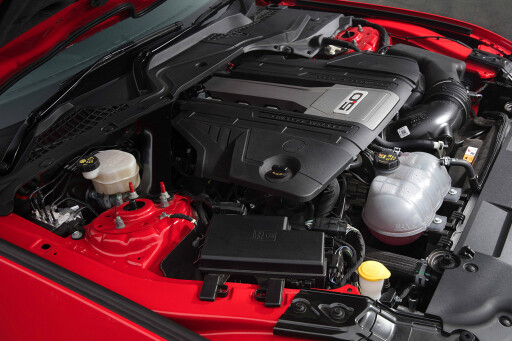
The GT Fastback versions can be had with a six-speed manual or efficient 10-speed automatic transmission, while the Convertible is automatic only.
Fuel economy in with the manual gearbox is rated at 13.0 litres/100km on the combined cycle, and 12.7 litres/100km with the auto. Expect that to be more in real-world driving conditions.
A limited-edition, factory supercharged version called the Ford Mustang R-Spec arrived in showrooms in early 2020 with Ford Performance supercharger kit providing power figures of 520kW/820Nm and consumes petrol at a greedy 14 litres/100km with the manual gearbox, which is the only option.
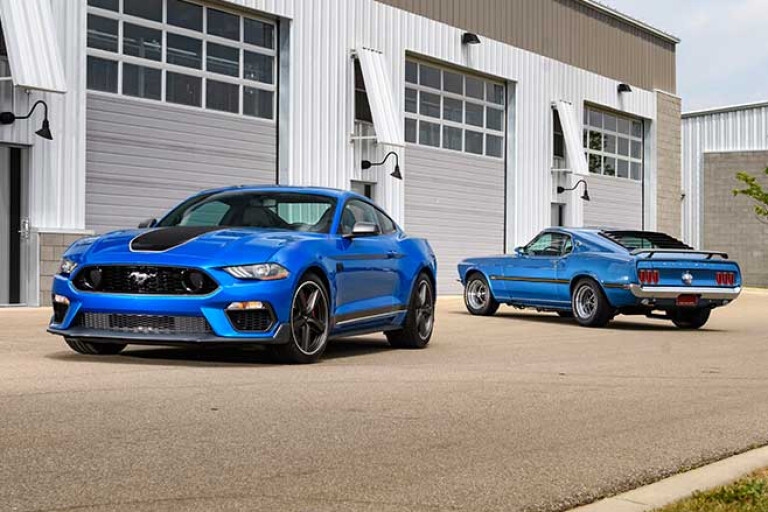
Another limited edition, the Mustang Mach 1 pushes out 345kW and 556Nm and has a fuel consumption rating of 13.9 litres/100km with the manual transmission and 12.4L/100km with the 10-speed auto.
The main reason you'd choose either limited edition version, apart from the enjoyment of having that additional power, is the fact they're instant classics that will hold their desirability and value.
What key features do I get if I spend more?
The biggest difference between a Mustang High Performance 2.3L and a more expensive Mustang GT, apart from the grille, will be under the bonnet. Which means spending more will get you the V8 engine and not much else.
That said, you do get bigger brakes and quad-exhaust tips on the V8-powered GT models, and slightly wider rear wheels and tyres to provide added grip to deal with the extra power.
You also get less roof, with the convertibles costing around $12,000 more than the automatic Fastbacks.
The 10-speed automatic gearbox attracts a $3000 premium over the manual.
Other options include ‘MagneRide’ adaptive suspension, which adjusts the dampers to suit the different driving conditions. You can also add a rear-spoiler, attractive over the top stripes, and Recaro leather sports front seats.
The Mustang Mach 1 brings unique exterior styling and the more powerful engine. Extra-cost options include Recaro seats for an extra $3000, while premium paint will cost $650.
There's also a special Appearance Pack for one particular paint shade, known as Fighter Jet Grey (below). A $1000 kit will add orange accents to the interior, an orange stripe on the bonnet and down the sides, and orange brake calipers.
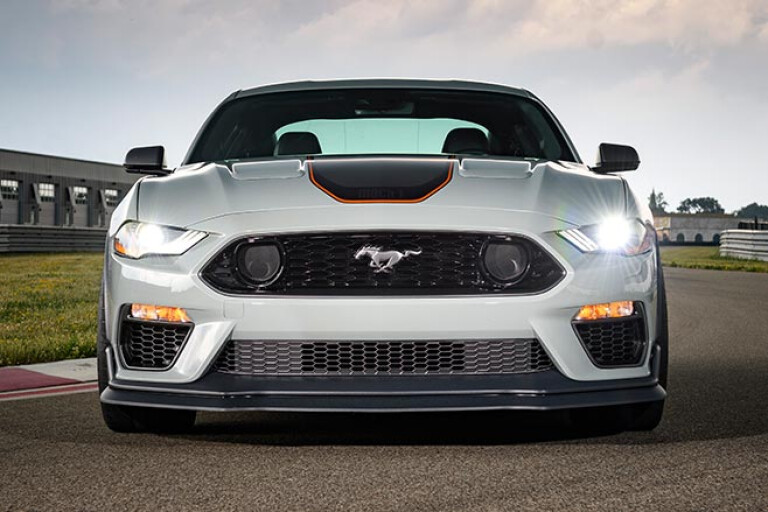
You can also pick from Shadow Black and Oxford White with Satin Black/Red stripes, or Velocity Blue and Twister Orange with Satin Black/White stripes.
Spending more again on the Mustang R-Spec brings the supercharged engine, 19-inch performance rims and tyres (below), and additional exterior embellishments.
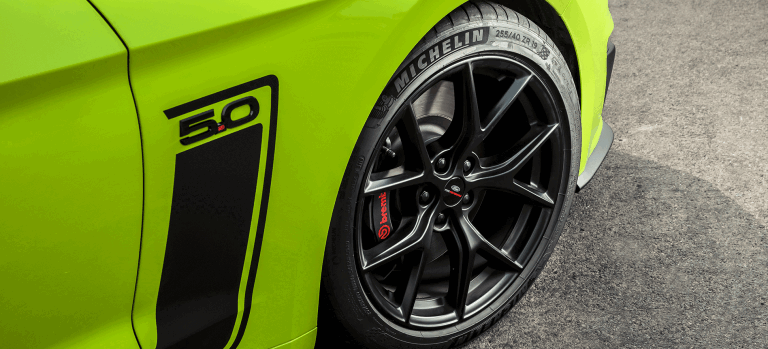
Does any upgrade have a down side?
A move to a GT, with the V8 engine, means you’ll pay more initially and will use more fuel on a day-to-day basis. As well, Mustang GTs don’t carry a spare tyre. (Ford says their brakes won’t accommodate the space-saver spare wheel that comes with 2.3L Performance Mustangs.)
Paying extra for the automatic transmission option with the 2.3L turbocharged engine involves a small fuel-economy trade-off too, as well as making for a performance car that is not quite as satisfying to drive.
If you do decide to spend bigger and go for the Convertible with either engine, you can’t have it with the manual transmission: it’s automatic only.
There are plenty of colour options for the Mustang but what Ford calls prestige paint (effectively metallic colours) costs about $300 extra.
How comfortable is the Mustang?
The current Mustang represents a big improvement over its predecessor when it comes to interior quality and comfort.
The inferior quality hard plastics were binned and replaced with soft-touch door trims, while stitched trim coats the entire centre console. The centre and door armrests feel softer underhand and elbow, and even the leather steering wheel feels suppler.

The messy instrument cluster was replaced by a 12-inch digital unit with a customisable display that offers three instrument styles including Racetrack’ version featuring a strip-like tacho that curls up from the left and across the upper dial section, like a speedo from a ’60s T-Bird.
The standard front seats are good, with heating and ventilation. They are a generous size and offer plenty of support.
The rear seats look plush buy are token at best with barely any legroom, and will not be suitable for long trips with anybody bigger than a toddler.
The Mustang is still a sports car, though, so the firm ride and loud engine noise, even with the 2.3L turbo, might not be as enjoyable for passengers as it is the driver.
What about safety in a Ford Mustang?
Unusually, the Mustang has knee air-bags for the passenger as well as the driver, for a total of eight airbags. The others are immediately in front of the driver and passenger, thorax airbags either side of the driver and passenger to protect their upper bodies from side-impacts, and side-curtain airbags to protect the heads of both front and rear-seat passengers. A reversing camera is standard.
Ford has used stronger than normal steel in some structural parts of the car’s body for a stronger passenger cell – the part of the car that contains the passengers. The idea is that if the passenger cell deforms less in a crash, the occupants are less likely to be injured.
An interesting addition is Ford’s MyKey system, which allows parents to program the car (via the ignition key) to protect their offspring from injudicious impulses. You can limit its top speed, limit the stereo volume, block phone calls and text messages when driving, and even increase the frequency of the seatbelt reminder.
Autonomous emergency braking is now standard in the Mustang, the absence of which restricted its Australasian New Car Assessment Program (ANCAP) safety rating to just two starts for the previous model.
Adaptive cruise control and lane-keeping assist is also standard, but it still lacks blind-spot warning and rear-cross traffic alert, which are standard in many more affordable cars. And the seatbelt reminder operates only on the front seats.
Despite the addition of autonomous emergency braking, ANCAP only raised the 2018 Mustang’s safety rating from two to three stars, from a maximum of five, in December 2017.
Because this was only a facelift, the 2018 model still showed previous model's flaws in crash-testing, including poor passenger protection in the rear seats, with serious head, chest and leg injuries likely from a 50km/h frontal impact (because seatbelts could not restrain rear passengers safely).
The driver and front passenger fared much better, with protection from frontal, frontal offset and pole impacts rated as acceptable (one down from good, the maximum of four levels), and from side impacts rated as good. Nevertheless, in the frontal offset test the airbags allowed driver and passenger to contact the steering wheel or dashboard with their heads. Whiplash protection from rear-end crashes was also rated as poor in the rear seats, and marginal in the front.
I like driving - will I enjoy this car?
This is the Mustang’s reason for existing. Either engine offers a lot of acceleration and make for very safe overtaking and effortless freeway cruising.
The V8 will excite keener drivers more, with a fabulous soundtrack through the quad exhaust pipes, and a bigger shove in the back when you accelerate hard.
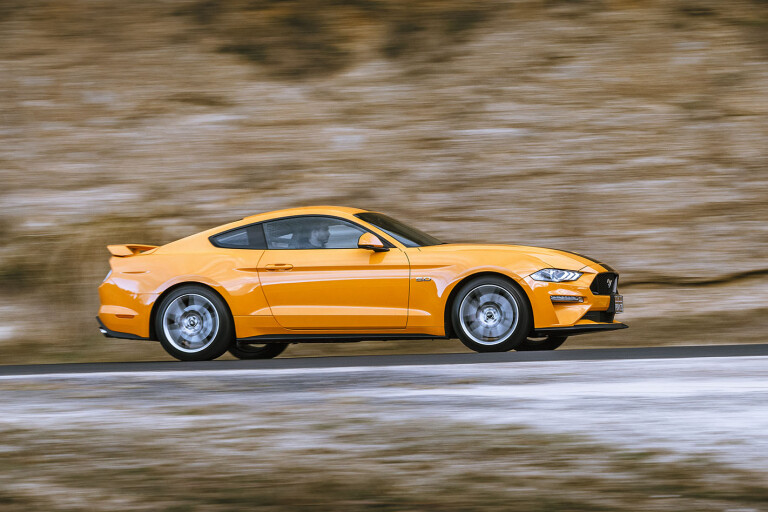
The High Performance 2.3L is no slouch though and still provides an enjoyable driving experience, especially in the convertible. It also has a decent exhaust note that can be adjusted between normal and throatier sports mode.
The steering is not as sharp as some, but it certainly gives a feeling of great security and has a meatiness to it that lets you know you’re driving a substantial vehicle.
There’s no escaping the fact that the Mustang is a big, wide and relatively heavy car. But even then, it disguises those things to a large extent and emerges as a fun, entertaining car. Big brakes, well-considered suspension settings and sticky tyres all help to achieve that feeling.
While the six-speed manual was always going to be the purist’s choice, the new 10-speed auto, with launch control, is excellent, with almost flawless shifting.
And regardless of which engine you have, any Mustang is guaranteed to turn heads.
How is life in the rear seats?
No elephant stamp, here. The Mustang’s rear seat is tight to say the least, and in the convertible model it’s even narrower as the roof mechanism encroaches. The rear seat also consists more or less of two shaped bucket seats rather than a bench that would accommodate three backsides.
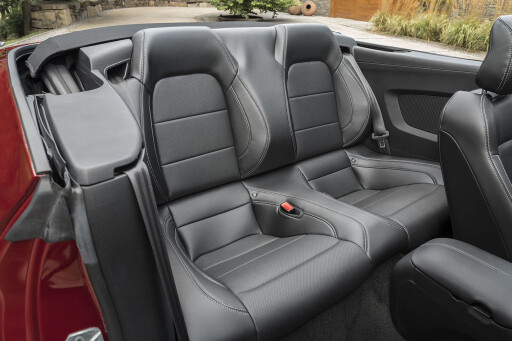
Access to the rear is tricky, too, and the front seats have to be folded forward before you can enter or leave the rear seat. While front seat passengers can use a little leather retaining strap on the seat-back to prevent the seat-belt from slipping behind them every time they leave the car, that same belt-tethering device poses yet another obstacle for those attempting to access the rear seats.
Nor is the rear of a Mustang a very safe place to ride in. Safety body ANCAP has highlighted poor protection from frontal crashes and poor whiplash protection. (For more on rear-passenger safety, please open the Safety section above.)
How is it for carrying stuff?
Given that the rear seat is all but useless for adults, this is where some owners will put a lot of the gear they need to carry. Which is just as well, because the boot space is compact compared to similarly sized vehicles.
The short rear overhang of the body that characterises the macho styling limits the load area the boot can physically offer.
What’s more surprising is that the interior doesn’t feature the plethora of cup-holders you’ll see on any other modern American car, each capable of locating a small bucket. Instead, you get two average sized cup-holders in the centre console (which interfere with your gear-shifting if there’s anything in them) and tiny bins on each front door-trim. Other stowage points are in short supply, too.
Where does Ford make the Mustang?
All Mustangs are made in the USA at Ford’s Flat Rock assembly plant in Michigan.
Are there any rivals that I should consider?
Now the Aussie-built V8 Ford Falcons and Holden Commodores are gone, nothing else provides as much performance bang for your buck than the Mustang.
The Chrysler 300 SRT is the only other comparable V8 muscle car there is before you start adding an extra zero to the price tag.
If you’re not too fussed about having V8 power the Lexus RC350, Kia Stinger GT are fun-driving options that offer a little more family friendliness. But they won’t feel like or turn heads like a Mustang.
The 2.3L Performance Mustang is cheaper than similarly powered German coupes and convertibles such as the Audi A5 and Mercedes-Benz C-Class, but is no less enjoyable to drive and is likely to turn more heads.
The 2.3-litre Convertible could also be on the list for anyone looking for an affordable roadster such as the Mazda MX-5 and Fiat 124 Spider.
I like this car, but I can't choose which version. Can you help?
The pick is the GT (V8) coupe with the smooth-shifting manual transmission, for its combination of performance, street cred and old-school driver involvement. The new 10-speed automatic is no lazy shifter though, providing almost flawless shifting that makes the most of the V8's performance and is excellent for cruising.
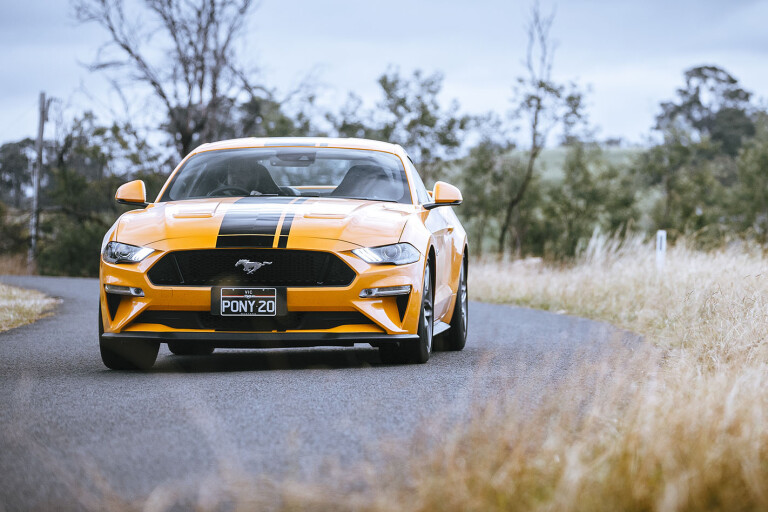
If you love the idea of having a Mustang but baulk at the high fuel bill, the High Performance 2.3L (formerly known as EcoBoost) versions are an excellent compromise. The Convertible is the pic of these as the thrill of open-top driving goes a long way to compensate for not having that V8 grunt and growl.
Are there plans to update the Mustang soon?
Ford launched the current-generation Mustang in the US back in 2014, but it did not arrive in Australia until January 2016. Mustangs built after June 2016 gained Ford’s SYNC3 connectivity suite, bringing support for Apple CarPlay and Android Auto. As the same time, Ecoboost Mustangs picked up a space-saver spare tyre.

The Mustang received a mild facelift and significant equipment upgrade for the 2018 model year, bringing the 12.0-inch digital gauge cluster, a suite of driver aids, improved interior quality, a more powerful V8 engine, and a 10-speed automatic transmission. The V8 GT Coupe and Convertible arrived in June 2018, with the 2.3-litre four-cylinder EcoBoost following that September.
In October 2018 Ford Australia introduced the Mustang Bullitt, which is the most powerful factory Mustang ever offered in Australia. Limited to 700 units, the Bullitt has a more powerful version of the 5.0-litre V8 engine that's linked to the six-speed manual transmission with rev matching.
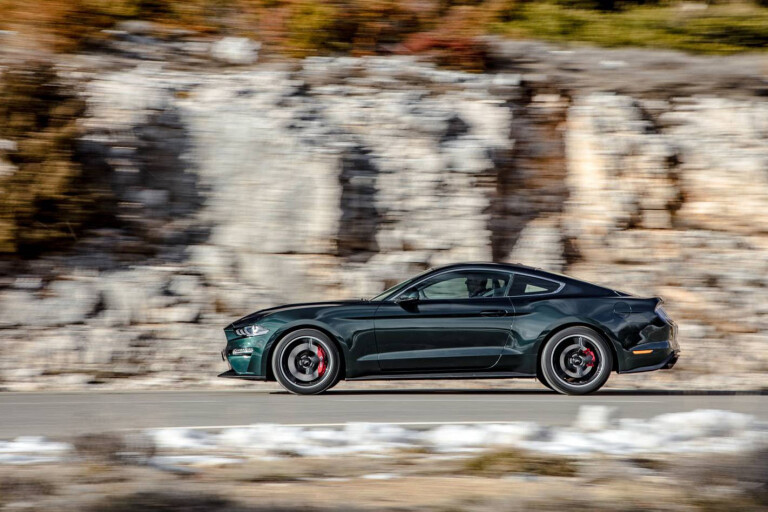
True to the 1968 original from the film, each Bullitt has a Fastback body with extras including 19-inch alloy wheels, red Brembo brake callipers, chrome window trim and individually-numbered plaque, cue-ball style gear-knob and Bullitt badging.
In early 2020, the Mustang Ecoboost received a more powerful turbocharged engine and was renamed the Mustang 2.3L High Performance. Ford also introduced a limited edition, Australia-only, supercharged V8 version called the Mustang R-Spec followed by the 2021 Mustang Mach of which 700 will be sold.
Score breakdown
Things we like
- A modern muscle car with great street cred, V8 soundtrack, manual and auto transmissions, auto braking
Not so much
- Thirsty V8, impractical rear-seats, sub-optimal crash-protection
COMMENTS